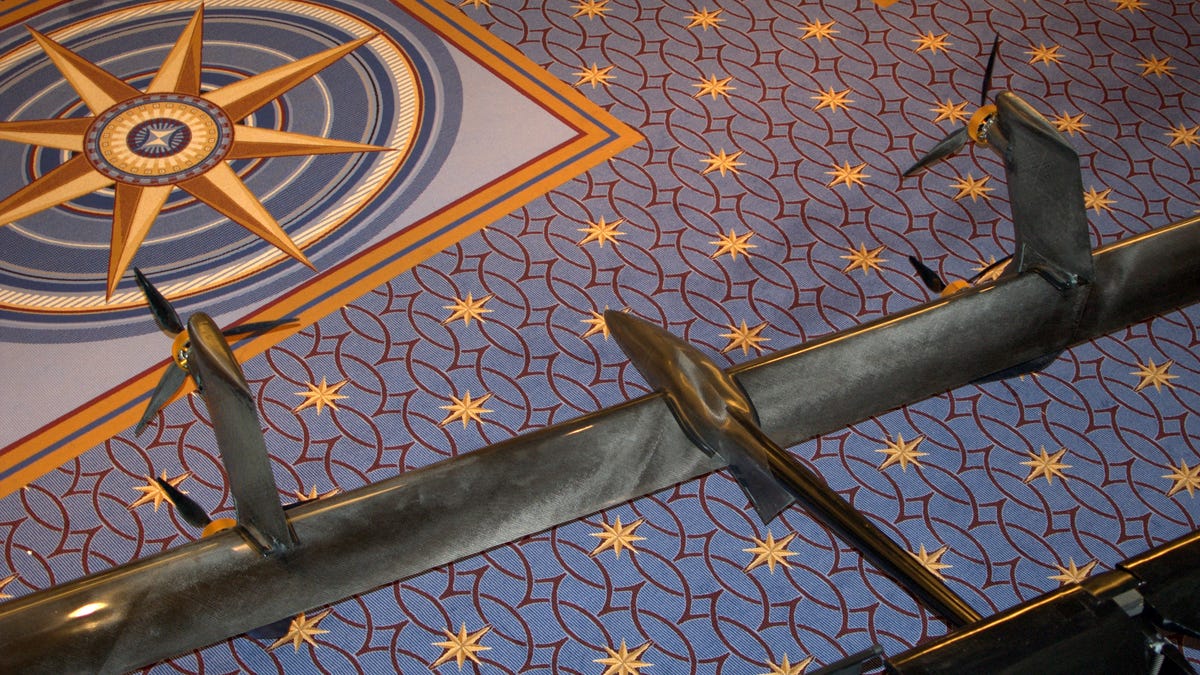Lightweight wing harvests offshore wind
Startup Makani Power clears its first hurdles in building a radically different wind turbine that flies like a kite and captures high-altitude winds.

It's a flying wing, a power generator, and a robot.
Startup Makani Power is developing a wind turbine that's a big break from convention. If it works, it could slash the cost of wind power, particularly offshore.
The company has nearly finished testing flights for a 30-kilowatt prototype turbine and will soon begin work on a larger, commercial-scale system, according to CEO Corwin Hardham. The goal is to complete development and testing that full-scale, 600-kilowatt system by 2016, he said.
Makani Power, which was originally funded by Google and later by the Department of Energy's ARPA-E agency, is one of a handful of startups trying to tap the strong winds at higher altitudes that conventional turbines can't reach.
No high-altitude wind company can claim to be generating power into the grid but Makani appears to be closest to commercialization. It's been at it since 2006 and it has sped up its progress by tapping technology from disciplines outside energy, including computing and robotics.
"The whole wing is just a big robot," Hardham said. "The brain of the wing is almost like your iPhone and because of the immense computational power, we're able to do things that 20 or 30 years ago would been very difficult to do."
The wind turbine is a wing equipped with small rotors that act either as a propeller to fly the device or as power generators. It's tethered to a cable which provides power when needed or transmits the electricity the turbine generates.
In its tests, engineers showed that the carbon fiber wing, which is about 25 feet across, can lift off and position itself to face the oncoming wind. When there's sufficient wind, the turbine starts a circular path and begins generating electricity.
An onboard processor collects and analyzes data, such as wind speed, to optimize the flight of the wing in a continuous path. The company has also designed a system where it can take off from a perch and land back on the perch autonomously if there's a need for maintenance or winds are too high or too low.
Heading offshore?
The wing flies at about 150 miles per hour in a similar circular route as the tip of a conventional wind turbine's blades. But because it's a kite, rather than full-scale turbine and tower, it can capture wind from a higher and larger area and the device itself can be built at a lower cost, Hardham said. The design also allows it to generate power from relatively low-speed wind, meaning it can operate for more hours than traditional turbines, he added.
The company estimates that tapping offshore wind would cost about 7 cents per kilowatt-hour, which is less than half the cost of current offshore wind prices. A big part of the savings comes from using less steel and other materials.
"We can get to wind with about 10 percent of the mass of a floating offshore wind turbine. Because of that, we are able to explore deep water wind with a cost of energy almost reaching wholesale grid parity," he said.
There are already gigawatts' worth of offshore wind turbines installed in Europe and a few proposals, including Cape Wind, in the U.S. But offshore wind is more expensive than onshore wind and, although there's typically steadier wind, prices go higher as turbines are moved into deeper waters.
Hardham projects that an offshore wind farm of Makani's turbines would be placed about 10 miles off shore where there is a good wind resource. The turbines would perch themselves to a floating platform and transmit power through a cable to the grid, he said.
To get to its current design, company engineers created a simulation environment in software to optimize the wing's flight path and aerodynamics, Hardham said. The onboard computer allows the turbine to not only direct its flight based on sensor and GPS data but also operate autonomously like a robot.
Modern computer technologies have helped the company move relatively quickly for the energy business but the safety and reliability demands of the energy industry means product development takes years. "Unfortunately, one of the things that's most difficult about what we're doing is that it takes time. You're trying to demonstrate a reliable system," Hardham said.

